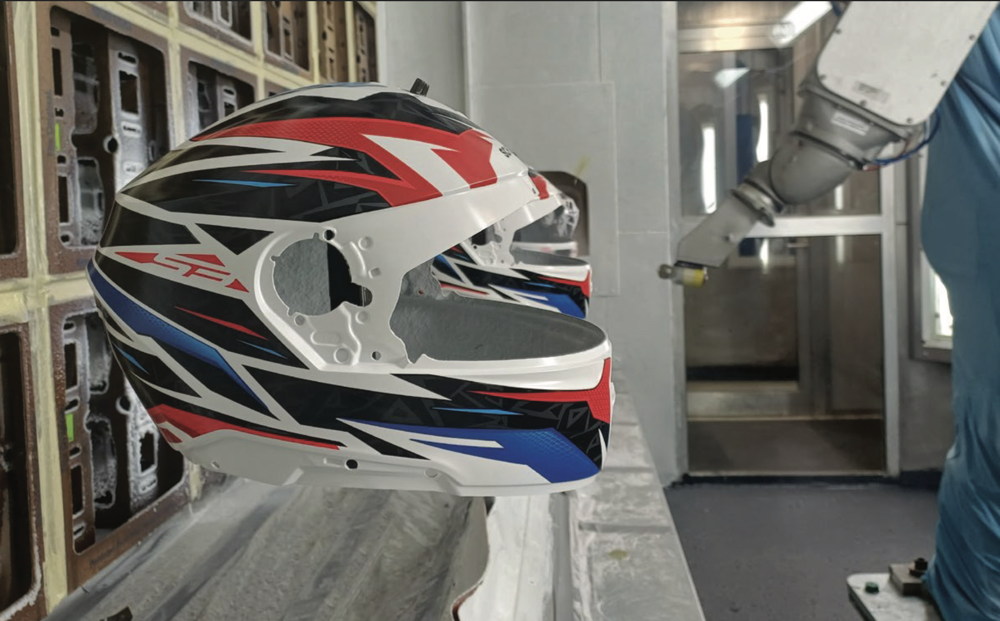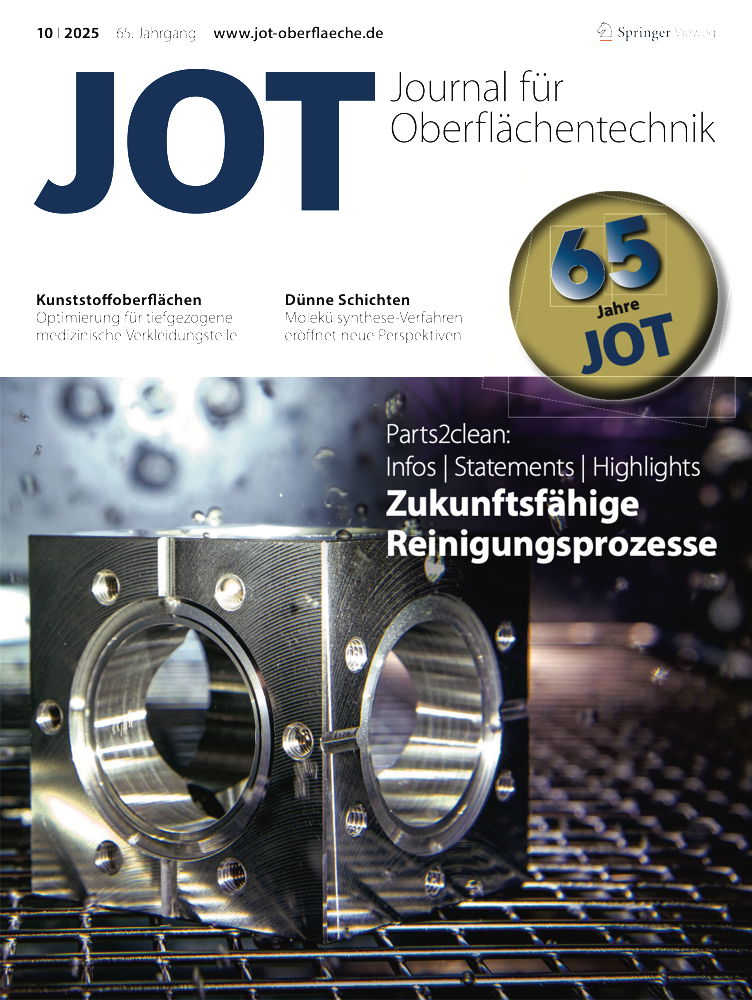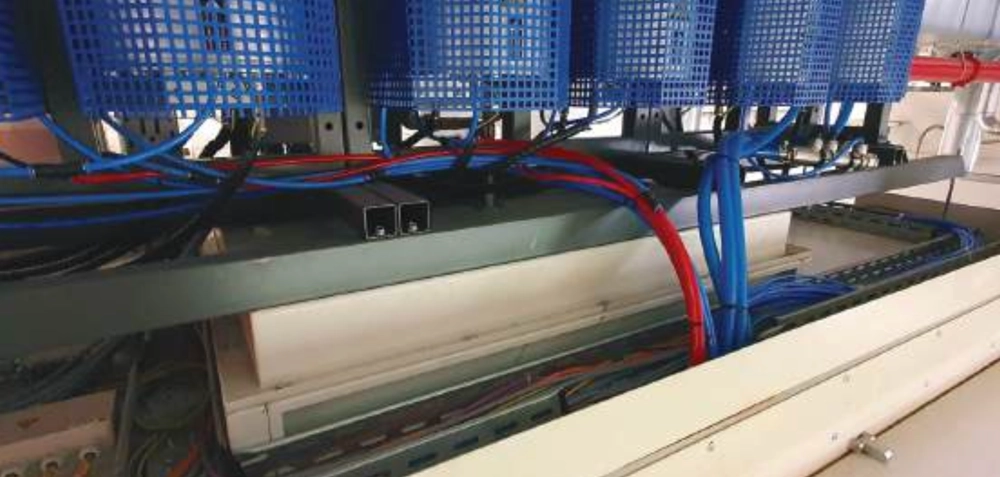Der folgende Bericht erschien im Journal für Oberflächentechnik – JOT) – Ausgabe 10/2025. Wir veröffentlichen ihn im Wortlaut:

Serienlackierung der S3-Helmschalen mit Dekor-Applikation des glänzenden Klarlacks. (Foto: Schuberth)
A German company develops and manufactures helmets where safety is the top priority. The surface finish also plays a decisive role here. It is an expression of the high level of quality. With a special atomization optimization, the helmet manufacturer was able to further improve surface quality, efficiency and use of resources.
„Die Qualität hat bei uns immer oberste Priorität. Da machen wir keine Kompromisse, niemals!“ Das sagt Martin Schwenke, Betriebstechnologe für Oberflächentechnik bei der Schuberth Holding GmbH in Magdeburg. Das Unternehmen produziert Kopfschutzsysteme – Helme für Motorradfahrer, für den Motorsport sowie für den Arbeitsschutz, die Feuerwehr, die Polizei und das Militär. Beim Lackieren der Helme kommt inzwischen die airmatic-Zerstäubungsoptimierung zum Einsatz – ein innovatives Gerät der ensutec Products GmbH aus Langenenslingen in Baden-Württemberg.
Thanks to the airmatic atomization optimization, the paint is atomized more finely and evenly during the spraying process. Homogeneous droplet sizes ensure that the paint is distributed more evenly on the surface and that even complex geometries are better reached. At the same time, the integrated electromagnetic unit (EMP) neutralizes static charges on the workpiece and in the paint cloud - this prevents paint particles from being deflected in an uncontrolled manner or contaminated by dust particles.
The result is a significantly more homogeneous paint layer with higher opacity and a more brilliant surface finish. In addition to the increase in quality, overspray is reduced, compressed air requirements are lower and drying times are noticeably shorter. Thanks to the more precise application, reworking such as sanding or polishing is often only required to a small extent, which represents a clear advantage in terms of efficiency, material usage and sustainability.
According to Schwenke, the technology has not only simplified the painting of the helmets, but also noticeably improved it. And this in turn has a side effect that is surprising in its clarity: 8 % to 23 % could be saved on the base coat and 13 % to 19 % on the clear coat. For small parts, the savings are even more significant: „Here we achieve an average of up to 25%, sometimes even 36 %,“ reports Schwenke.
Diverse requirements complicate the painting process
Before the helmets enter the paint booth, the helmet shells are primed and sanded and the add-on parts are cleaned with isopropanol. All components then pass through an ionization station, which removes any static charge. This prevents the attraction of dust particles and ensures an even coating. This is followed by two coats of colored paint before the helmets are cured in the dryer. Finally, a UV-curing clear coat with a small amount of solvent is applied to ensure lasting shine and protection.
Schuberth is currently working on the introduction of automated pre-cleaning for all parts. Painting plastic components is a demanding process full of pitfalls. The very smooth, non-porous surface makes it difficult for the paint to adhere. In addition, plastics attract dust and fibers - tiny particles that settle on the surface before painting and can later cause irregularities in the finish.

The helmet shells from Schuberth have an additional dimension: they are produced using Direct Fiber Processing (DFP), a complex process in which glass fibres and carbon fabric are processed in a resin matrix over several steps. This complex combination of materials ensures maximum strength, but poses particular challenges when it comes to painting.
Another difficulty that needs to be overcome is the increasing complexity in the construction of helmets due to new design specifications and special customer requirements. The helmets have ventilation slots and air ducts, recesses and edges and often many small attachments. All of this makes it extremely difficult to apply the paint evenly. In addition, the layers of paint have to be opaque on the one hand and very thin on the other. Even minimal deviations in the layer thickness can change the color, affect other parts or disrupt their function. And last but not least, there are always new environmental and occupational safety requirements. For example, the switch from solvent-based to water-based paints at Schuberth took over 14 years. Thanks to close cooperation with paint manufacturers, this process was finally completed a year ago.
A uniform spray bar simplifies programming
The fact that Schuberth now uses the airmatic atomization optimization is due to a small coincidence: Schwenke received the documentation for the airmatic devices from Ensutec during his dual studies. However, it was not until years later, when he was responsible for technology in the coating and decor area, that Schwenke began to study the information more closely. After a thorough examination, Schuberth finally approved the investment.
Today, Schuberth has installed an airmatic atomization optimization system with integrated temperature control on the three robots of the top coat lines. Before its introduction, programming was much more time-consuming: the complex geometry of the helmets with numerous design edges, undercuts, openings and changing inner and outer radii required time-consuming adjustment of each individual spraying process. Added to this was the typical tendency of conventional spray jets to apply more paint in the middle than at the edges. This is an additional factor that required precise corrections and a lot of programming work.
The airmatic atomization optimization now ensures that the spray jet is much more uniform. And this in turn makes writing programs much easier. The already very high-quality surface is further refined by the new technology. The optimized coating quality also leads to a significant reduction in paint consumption - not as a primary goal, but as a direct result of the precise and uniform operation of the system.
After the first applications with the airmatic, however, unexpected problems arose: The feed pumps for the paint, which originally ran stably at atomization optimization with EMP units. 20 to 40 rpm, suddenly became too slow. The reason for this was that paint consumption had fallen so sharply that the pumps had to be replaced with smaller ones.
With airmatic technology, Schuberth can continue to meet and even exceed its quality standards. „In particular, we can now apply some effect and fluorescent colors such as our fluorescent yellow much more evenly,“ says Schwenke. This color must only be applied very thinly, but not too thinly, otherwise the color tone will change. With the new technology, Schuberth is able to stay within these tight tolerances better and more reliably.
Perfect surfaces - and enormous savings. Programming times have been shortened. Paint consumption has been significantly reduced. Not forgetting the compressed air: Schuberth estimates the savings here at 20 % to 30 %. It shows once again that innovative technologies can increase efficiency - and sometimes even further optimize an already perfect quality.

